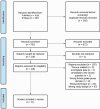Suture versus stapler in distal pancreatectomy and its impact on postoperative pancreatic fistula
- PMID: 39972194
- PMCID: PMC11840080
- DOI: 10.1038/s41598-025-90617-9
Suture versus stapler in distal pancreatectomy and its impact on postoperative pancreatic fistula
Abstract
Postoperative pancreatic fistula is a critical complication after distal pancreatectomy. The aim of this systematic review is to assess new reports on the main pancreatic stump closure techniques (stapler and hand-sewn suture) in distal pancreatectomy, to define their influence on postoperative pancreatic fistula rates. A literature review was performed following PRISMA guidelines (PROSPERO: CRD42023408181). The survey was conducted in Medline (via PubMed) and EMBASE. Clinical trials and cohorts were included if they assessed pancreatic fistula rates after distal pancreatectomy, and excluded if they used a fistula rating system other than the ISGPF one. The risk of bias was assessed using the Study Quality Assessment Tools | NHLBI, NIH. A meta-analysis was presented as forest-plots. Eleven articles were included, representing 1498 patients. No significant difference was found between Suture and Bare stapler (95% CI 0.91-1.68) or Bare stapler and Reinforced stapler for A-graded fistula rates (95% CI 0.78-1.28) and B-graded fistula rates (I-squared = 0.0%, p = 0.784). Most articles showed unclear risk of detection bias. This meta-analysis found no difference in fistula rates between stump closure techniques. This choice should be made by surgeons' and hospital administration's preferences.
Keywords: Fistula; Pancreatectomy; Surgical staplers; Surgical suture.
© 2025. The Author(s).
Conflict of interest statement
Declarations. Competing interests: The authors declare no competing interests.
Figures






References
-
- Navarro, S. The art of pancreatic surgery: Past, present and future: The history of pancreatic surgery. Gastroenterol. Hepatol.40, 648 (2017). - PubMed
-
- Chong, E. et al. Systematic review and meta-analysis of risk factors of postoperative pancreatic fistula after distal pancreatectomy in the era of 2016 International Study Group pancreatic fistula definition. HPB23, 1139–1151 (2021). - PubMed
-
- Morgan, K. A. & Adams, D. B. Management of internal and external pancreatic fistulas. Surg. Clin. North Am.87, 1503–1513 (2007). - PubMed
Publication types
MeSH terms
LinkOut - more resources
Full Text Sources
Medical

